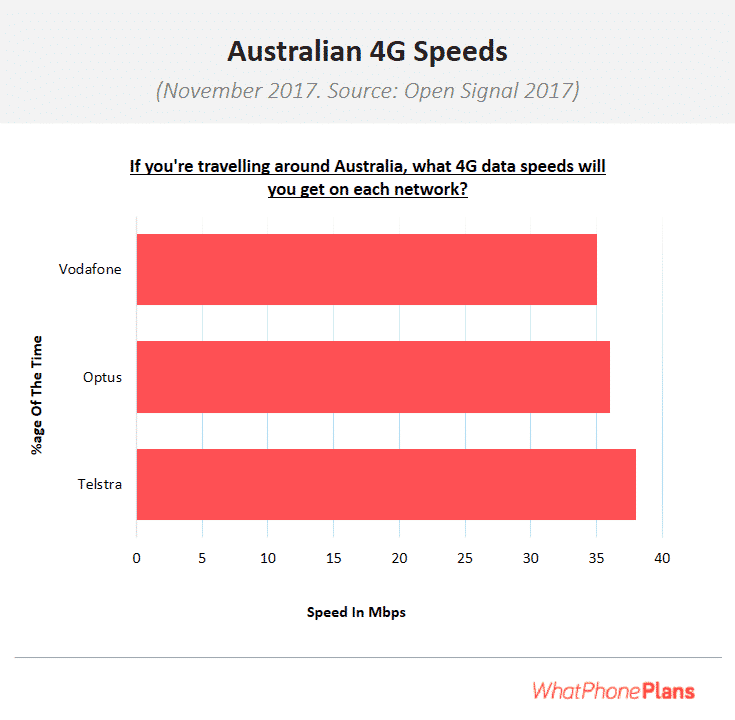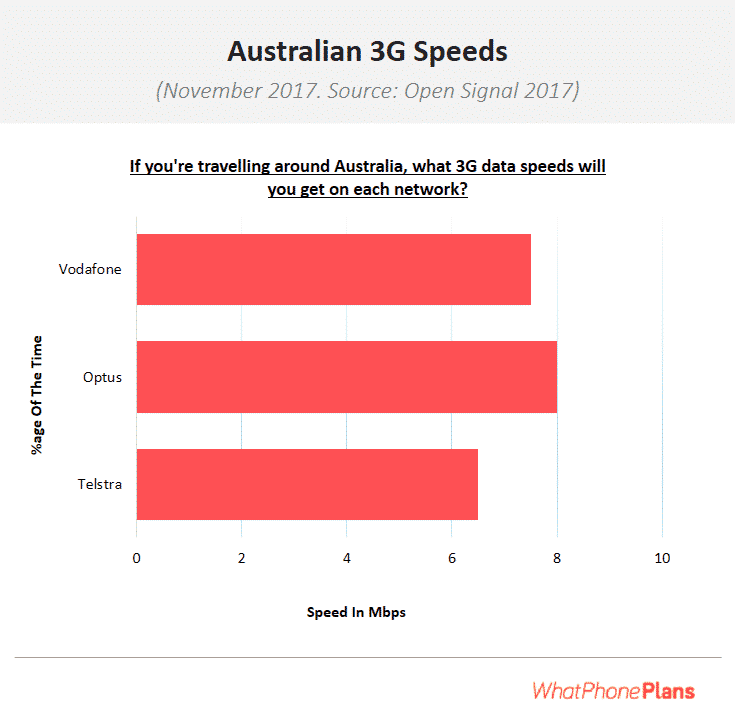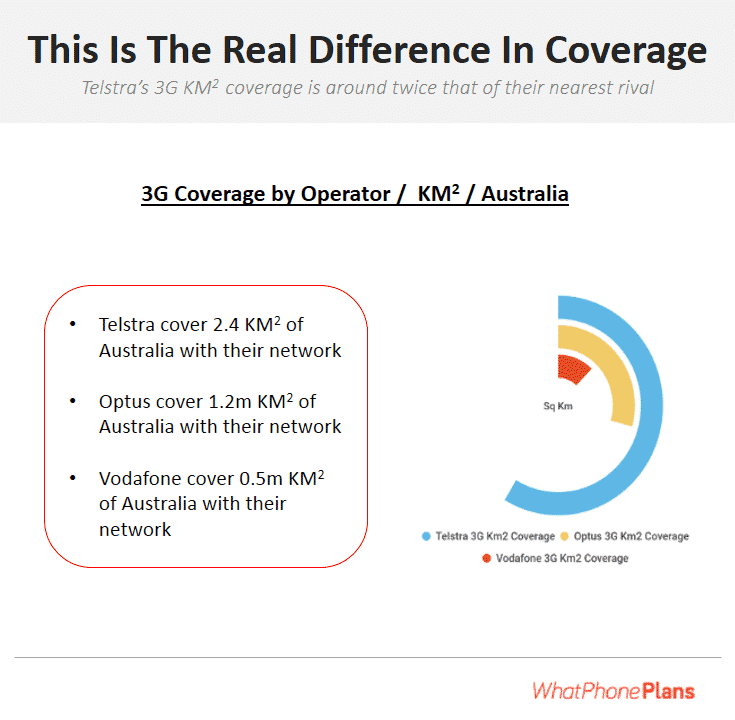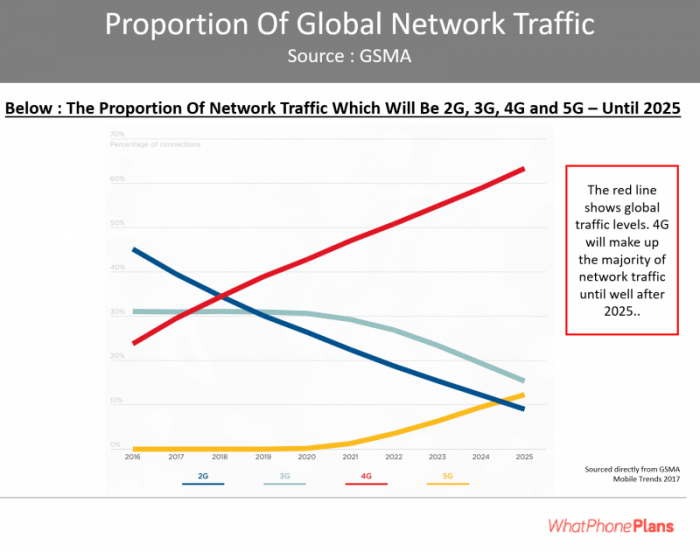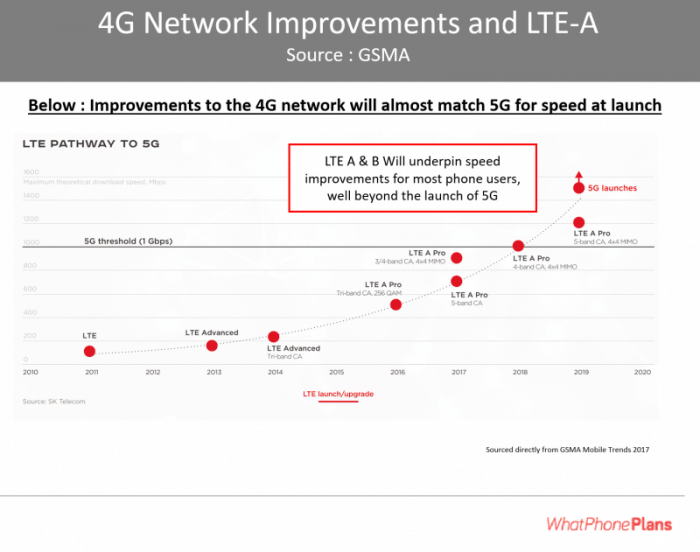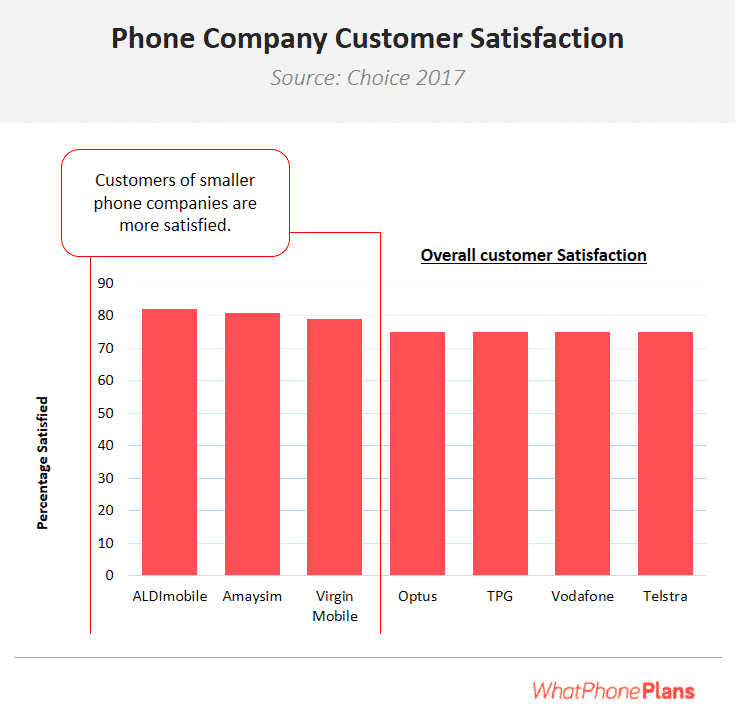Need more data or a cheaper plan?
How to get great network coverage at a better price
Smaller brands have great discounts, big data and are often cheaper than Telstra, Optus and Vodafone. You can choose from prepaid and postpaid with no lock-in contracts, and plans with long expiry dates. Explore plans here.
Need more data or a cheaper plan?
Need more data or a cheaper plan?
Coverage compared: Telstra, Optus and Vodafone
Telstra offers the greatest coverage, followed closely by Optus and then Vodafone. However, if you’re generally in a metro area you’ll find any network will be sufficient.
💡 All brands of phone plan providers use the Telstra, Optus or Vodafone network. If you live remotely, check the associated network’s coverage first.
Telstra’s coverage
Telstra covers over 99.5% of the population and is the largest (and oldest) mobile network in Australia. It’s likely rural customers will get reception with Telstra if they can’t with Optus and Vodafone.
Since 2020 Telstra has been rolling out 5G sites, which now covers 85% of the population. It spans selected areas of all capital cities and a further 400 cities and towns. Telstra plans to cover 95% of the population by 2025.
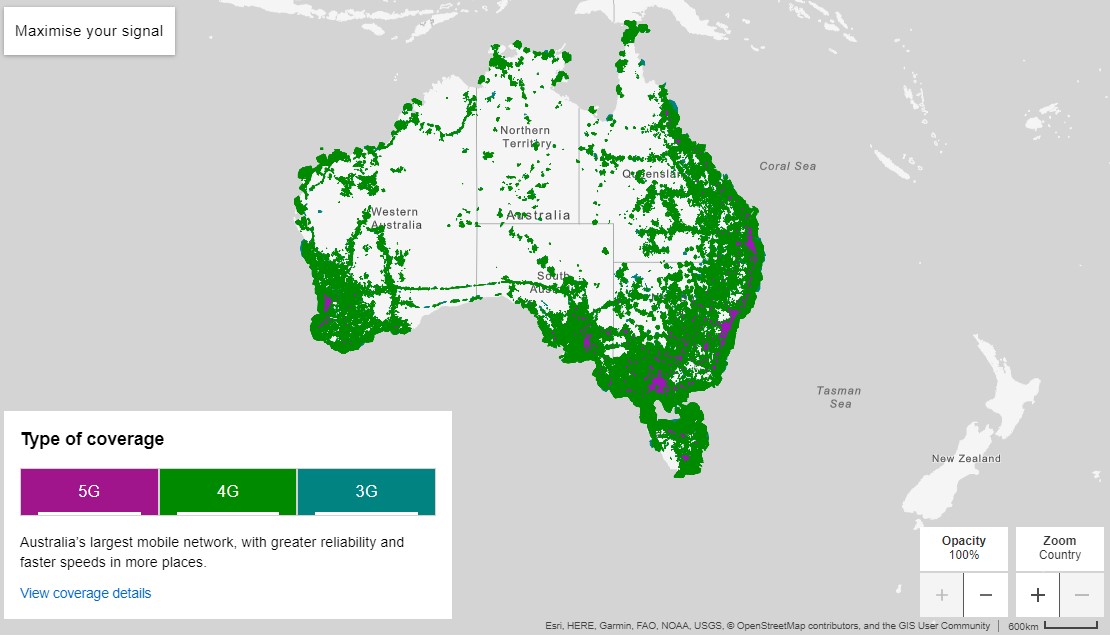
Recommended Plans on the major networks
There are the only 3 Mobile Network Operators (MNO) in Australia, but there are many phone companies. TPG Telecom (Vodafone), Optus, and Telstra are MNOs that each own their own network. However, a recent development has shaken up the market – Telstra and TPG Telecom have agreed to share their mobile networks, which could boost TPG Telecom’s coverage significantly. In the telecommunications industry, the big 3 are known as Tier 1 telcos. Other companies are Mobile Virtual Network Operators (MVNOs) that resell access to those networks.
From a coverage point of view, each of the 3 major phone companies spend significant amounts each year, often making multi-billion dollar investments in their networks. Their goal is to improve coverage and provide the latest 4G and 5G services to their customers.
In addition to maintenance, every 10 years or so, a new generation of network technology comes out. Originally, GSM was rolled out. That was upgraded with GPRS. That was followed by 3G data, then 4G data. In late 2014 with trials that commenced in July, a new 700 MHz spectrum was trialled by Optus and Telstra which doubled 4G speeds and improved in-building reception. And now, all three of the major telcos are rolling out their 5G networks, and some MVNOs are now reselling those 5G networks.
This constant attention to network provision and upgrade costs these companies a lot of money. In 2015, attention turned to increasing the proportion of the population covered by 4G networks and adding even more capacity to existing 4G networks, a process which is still ongoing now. 2018 saw Optus win best network and Vodafone roll out 140 new base stations.
Considering the phone networks of smaller phone companies
There are other companies, nearly 50 in total, which use the tier 1 Telco’s networks. These phone companies are known as MVNOs or Mobile Virtual Network Operators. They often provide their customers exactly the same networks as customers who buy their phone plan from, for example, Vodafone and Optus, direct. One of the secrets of Australia’s MVNOs, however, is that they do not charge anything like the tier 1 telcos for their services. Remember, MVNOs typically offer SIM Only plans. Using them can save you a fortune without requiring that you compromise interest in the network you choose.
In depth information on Telstra's, Optus', and Vodafone's network
We’ve comprised all the information you need on the major Australian networks and provide it here, all in one place.
Australian Network Coverage
There are a variety of credible (independent) information sources available to establish which phone companies offer the best mobile phone plan coverage in Australia. We try to reference as many as possible here to assist your decision on which to choose. Our own 2018 research (shown on our homepage) indicates that 40% of Australians would like to change networks in the next year. Coverage is a key factor in that decision-making process.
Potentially the most important report about phone companies in 5 years, a recent ‘Open Source’ white paper revealed some surprising news. In major metro areas, Vodafone had the best 4G coverage and the best 4G speeds. Complaints to the TIO about Vodafone – the Telecommunications ombudsman halved between the worst days of ‘Vodafail’ and now. And this year 2022, Vodafone and Telstra have struck a deal to share their mobile networks, which will expand Vodafone’s coverage even more. These are just a few of the facts showing that the Vodafone network has improved substantially since its bad days.
Also, when you include the other elements of the service you’re offered by your phone company, it gets interesting. Looking at customer service and overall customer satisfaction from Australian phone companies, there are clear winners and losers. So, Telstra does have the best network but the research says they may well not be the best phone company for you. As we show below, if you do want access to the full Telstra Network but you find their pricing too expensive, you have alternatives.
This Month’s Hot Offers
And while 3G and 4G networks have the widest coverage in Australia right now, 5G networks are also expanding. We’ll touch on 5G coverage and the number of towers / sites each major telco currently has, later on in this post.
Recent changes in Australian 4G Coverage
Low frequencies like 700 MHz or 850 MHz improve in building coverage and reach in to the bush. Remember, not all phones have access to frequencies like Optus and Telstra’s 700 MHz.
In late 2015, the competition between the major networks for 4G coverage and speed took an interesting twist. Each player is now attempting to make the best use of their network frequency investments to improve both the number of square kilometres they cover and their in-building network penetration. Vodafone is reusing its 850 MHz frequency. Telstra deployed their new 700 MHz frequency assets. Each of these spectrum facilities is enabled by the closing down of Australia’s Analogue TV networks the year prior.
Additionally, you will have seen mention of the rollout of ‘double fast’ 4G networks using either TDD or FDD technology. This is sometimes called carrier aggregation. These represent the start of national coverage at even faster speeds than the 4G that some people have already started to use. Meanwhile, Vodafone has moved to a full IP network infrastructure and introduced VoLTE. We cover each of these points in the operator-specific section, below.
And most recently, Telstra and TPG Telecom (Vodafone) reached a deal to share their mobile networks. For Vodafone, this could mean a major boost in coverage in regional parts of Australia, because of Telstra’s wide 3G/4G coverage in the bush. This boost could result in a jump in Vodafone’s overall coverage from 96 per cent to 98.8 per cent. Telstra will also have access to as many as 169 TPG mobile sites, along with a predicted AU$1.6 billion to AU$1.8 billion over the 10-year lifespan of the network sharing deal.
Overall, these investments have left the major phone companies with very, very similar 4G coverage footprints and speeds.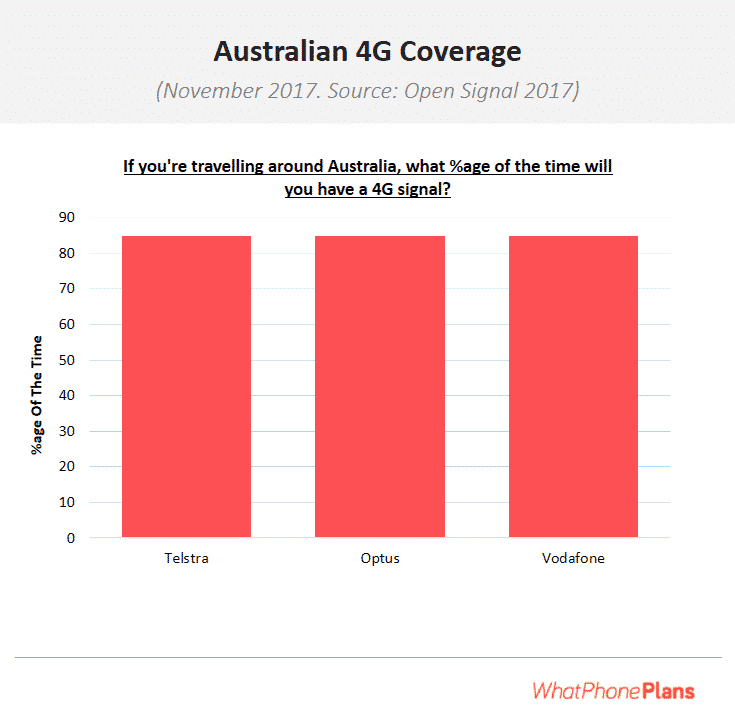
Comparing Telstra, Optus and Vodafone’s 4G population coverage
Comparing Telstra, Optus and Vodafone’s 4G speeds
Similarly, speeds available on the 3G networks of the major phone companies are also nearly identical.
Comparing Telstra, Optus and Vodafone’s 3G speeds
June 2017 : The key elements of Optus’ $1bn 2017 / 2018 AUD network investment
Optus announced, in mid 2017, that they intend to spend $1bn between June 2017 and June 2018 improving the number of towers and quality of their networks in those areas.
- The goal was to leave Optus with 7000 base stations. (Compared to Telstra’s 8600.)
- The investments targetted improvements for up to 2.8 million Australians living on the fringes of Optus’ existing coverage footprint.
- Provide 4G capacity to 200 existing sites across the country over the year ahead, 1800 of Optus’ existing 3G sites will be upgraded to 4G.
- Investments targeted a total of 500 new base stations.
- That includes 114 new base stations under the government’s blackspot program.
- It was Optus’ biggest capital expense in the 25-year history of the company.
Optus’ investment will affect Smaller phone companies :
These investments were also to the advantage of smaller phone companies ( also known as MVNOs ) which use the Optus network. If you’re thinking of taking a plan from OVO, Moose Mobile or Yomojo, your network just got bigger, too. Each has unfettered access to whatever speeds and coverage Optus provides its ‘retail’ (those who bought from Optus direct) customers.
However, It’s not just about $1bn :
Telstra started with an advantage when it came to coverage when the government span them off as a private telco a while ago. Then they spend $billions to maximize it when their 3G network launched. Since then, for decades, they have outspent Optus on base stations and coverage. Becoming a head-to-head competitor will involve Optus spending more than $1bn in order to catch up.
That said, a recent report showed that Telstra charges $15 per month more than other carriers because their marketing has convinced everyone their network is better. Over time, Optus new network capability is likely to erode that advantage.
Read more: Optus’ Mid 2017 $1bn Network Investment
The Key Things To Know About Australian Network Coverage
So, the statistics show the gap between the speeds and availability of Australia’s 4G cellular networks is actually very small. The same cannot be said for Australia’s 3G networks. Some mobile internet is better than no mobile internet. We got along fine with 3G speeds for around a decade and we did OK. With 3G, you can listen to a streamed podcast or watch a video on YouTube. The quality of a video watched over a 3G network will not be as good as you’ll get over a 4G network, however. The transmission capability of 4G allows higher resolution pictures to be built by your phone. However, most of the time, having any YouTube facility at all, is far preferable to having no internet signal at all.
Even Telstra’s network only covers only around one-third of Australia’s landmass. The fact that we humans tend to congregate together means that we’re mostly jammed into that space. Telstra’s next biggest rival for 3G coverage is Optus and they cover around half of the space Telstra does.
Comparing Telstra, Optus and Vodafone’s 3G speeds
The GSMA shows that the question ‘How’s your 4G coverage’ Will be the most important one, for some time.
Telstra do have the best network coverage in the bush
Telstra 3G network coverage
In addition to the information contained in the info-graphics on this page – key facts about Telstra include :
- Telstra Cover 2.4
million square miles of Australia
- Telstra’s 3G coverage includes 60% of the Australian bush.
- That’s around twice as much of Australia as some of the alternatives.
- Telstra’s network coverage represents 30.6% of the Australian landmass.
- Telstra Subscriber stats :
- Have 16.4
million mobile network customers.
- Market share : 39.9%
- Have 16.4
- Spending $2 – $3 bn per year on network improvements at the moment.
- Boost Mobile are the only phone company to resell the entire Telstra Mobile network.
- Boost’s pricing is often more competitive than Telstra’s.
Telstra’s 4G network coverage
- The truth is that Vodafone now match Telstra for 4G signal coverage. Vodafone customers receive a 4G signal 88.48% of the time
, Telstra customers receive a 4G signal 88.06% of the time
- Telstra have 7.7
million 4G customers
- Telstra cover 99.50% of the Australian population
- Offer the fastest 4G network coverage in the world according to a recent survey.
Telstra topped the charts in a recent 4G service survey with 64% availability and speeds of 24.5 Mbps 58% of the time. We beat South Korea ! - Telstra’s 4G network was also tested in the recent Opensource report.
- Telstra customers were in 4G signal for 88.06% of the time
- And, when they were in coverage, they received speeds of 40.11 Mbp
- (Where streaming High Definition video takes approximately 5 Mbps, and streaming Ultra High Definition 4K video requires approximately 25 Mbps)
It was back in 2008 that Telstra took the remarkable steps it did to invest in its network and differentiate itself with that attribute. In many ways, it was the genius of the CEO at the time, Sol Trujillo who insisted that the Telstra ‘Next G’ network would be the best in Australia and was prepared to spend the money required to make that happen.
Telstra are ahead in their network performance and are spending more on improving it than the competition. The AFR report that Telstra is spending ‘unprecedented amounts’ on network investment. And it’s paying off. Since mid 2011, they have grown the number of customers on their network by the better part of 1m customers. Telstra now have more than 15 million mobile phone customers on their network.
Cleverly, Telstra have kept their 4G network almost to themselves. They sell slowed down 4G services to providers including Belong Mobile, and Cmobile. However, Telstra save their full 4G network for 2 groups of people. First Telstra provides their network access to their own customers. Second, Telstra have one sub brand to which they provide the entire network – Boost Mobile. Boost Mobile’s coverage footprint is exactly the same as Telstra’s, but their pricing is usually much better. Use Boost as your clever way of getting the best of both worlds.
Telstra charge a premium for their network services. Their price plans are routinely $10 – $15 per month more expensive than the other networks. This poses a few natural questions.
- Do you live in a bushland area where you will use the edge in network coverage that Telstra has ?
- Is that benefit worth putting up with their bad customer service and high prices for ?
- Why not take a Boost plan?
Telstra’s 4G network coverage
4G or LTE networks are cheaper to operate once established and offer more efficient use of the wireless frequencies the phone companies have bought access to. To you, that means a 4G phone will give you a better network experience.
Telstra started rolling out their 4G services in November 2011, long before the other Australian phone companies. Telstra paid $1.3bn for access to the 700 MHz frequency in May 2012. By mid 2013, they covered 66% of the Australian population. Their target was to cover 85% by the end of the 2013 calendar year and they hit that milestone. In fact, they completed it a week early. They now cover 99.50% of the Australian population
of the Australian population with a 4G signal.
In a way which is similar to some of their main rivals but on a slightly larger scale, Telstra are rolling 4G coverage out in 6 cities as part of their 700 MHz commercial trial. Telstra have also been granted the license for this by the ACMA. Telstra’s trials will commence in Griffith, Mildura, Perth, Freemantle, Mt Isa and Esperance. And, again, like some of their competitors, Telstra are playing with double-speed LTE / 4G. Telstra have some places already in Australia where the double fast 4G (LTE-A) service is already available. Confusingly, Telstra do this under a different name : 4GX or 4GEXTREME, although the technology employed is very similar to others capabilities and trials.
Telstra’s ‘Air’ Network
Telstra have a second string to their bow when it comes to Australian network facilities. The canny telco has made the most of it’s national Pay Phone infrastructure to create a network of WiFi coverage which now offers an impressive number of WiFi Hotspots.
Back in July 2015, Telstra released 4000 WiFi hotspots nationally under their unique ‘Telstra Air’ service. This project was aimed at delivering faster speeds for those who use WiFi rather than Telstra’s cellular network, by splitting the traffic between both fixed and cellular connections. Telstra Air provides an easier way to scale to the rapidly rising growth of data on their network. It also provides a solution which ties Telstra broadband customers (who can use the national WiFi network hotspots for free so long as they share their own with the public) in to Telstra’s fixed and mobile services for longer. Telstra’s scheme is not unique in the world. It follows well trodden paths in the UK and USA. However, strategically, it’s brilliant, and the national rollout of the initial batch of 4000 hotspots was done at light speed (considering it was Telstra managing it.)
Telstra is provided nearly $50m a year by the Australian government for payphones. The payment is made as part of a much larger bounty, from which Telstra benefits, in exchange for which, they provide Australians with as much network coverage as is possible. In the Industry, the payment is known as the Universal Services Agreement and it has been around for a long time. Perhaps obviously, other tier 1 providers see this as an extremely unfair form of competition. More broadly, the discussion prompts some to consider whether Australia needs 3 national networks at all.
In the meantime, Telstra customers are often offered ‘Free WiFi’ at Telstra Air Hotspots around the country and it’s a useful facility. Originally, in 2014, there were only 4000 of these hotspots. The network has grown, however, and there are now, in total, around 650k of these hotspots – a simply enormous number. Telstra offers network coverage for free to non customers too although users would be wise to be cognoscente of the ramifications. Telstra recently started gathering and using data of this sort to target adverts.
What about Vodafone’s network ?
Vodafone’s 3G network
- Vodafone’s 3G network covers 96.00 %
of the Australian population
- They cover 0.5
square Kms of Australia with a 3G signal
- They cover 0.5
- Vodafone have 5.99
million mobile network customers.
- Market share : 39.9%
- Focus of network improvements :
- According to the newly appointed CEO of Vodafone Australia, the network is focused on acquiring customers with above average data requirements.
- Vodafone say they are spending around $1bn each year on network improvements.
- Vodafone’s publically stated 4G information is sparse
- Although they have said they cover 96.00 %
Vodafone 4G Network Coverage
- The truth is that Vodafone now match Telstra for 4G signal coverage. Vodafone customers receive a 4G signal 88.48% of the time
, Telstra customers receive a 4G signal 88.06% of the time
- Vodafone have more than 2.0
million 4G customers
- That’s huge, given they launched their network more than a year after their rivals.
- OpenSignal showed Vodafone had the best 4G mobile phone plan coverage & speed in Sydney in January 2014.
- Had first month of adding customers to their network since 2010, at the start of 2014, demonstrating the turn around in their network performance.
- If you’d like more information, you can see our infographic on that report.
- And, in a more recent OpenSignal report, Vodafone’s 4G network did well
- Vodafone customers were in 4G signal for 88.48% of the time
- And, when they were in coverage, they received speeds of 37.58 Mbp
- ( Where streaming High Definition video takes approximately 5 Mbps, and streaming Ultra High Definition 4K video requires approximately 25 Mbps )
Vodafone had so much ground to recover on network and network perception that they are focusing on the cities first. As you will have seen on this page, in many major Australian cities, Vodafone already claim the fastest 4G networks. They’re improving that with their 850 MHz frequency. It’ll deliver an immediate benefit to their existing customers. Incredibly, Vodafone’s network investments have turned the reality around. They now match Telstra for practical 4G mobile phone plan coverage.
Further, Vodafone have now inked a deal with Telstra to share their mobile network. This move will help Vodafone improve their mobile phone plan coverage in regional areas significantly because Telstra’s coverage in the bush is far beyond other telcos. The partnership will also boost Vodafone’s overall coverage by almost 4 percent.
Vodafone’s network improvements are paying off for new customers. The ‘Vodafail’ tag they received in 2010 is finally leaving them following one of the biggest corporate turnarounds in Australian history. The good thing is they know it and they’re working on the problem. Bill Morrow, the ( now ex ) CEO of Vodafone recently changed the company’s internal focus away from numbers and focused staff on the emotional aspects of their relationships with customers.
Vodafone have not yet invested in a national WiFi network in the same way Telstra have. Neither has Vodafone yet released a WiFi calling app like Optus has. What they have done, however, is invest nearly a year in migrating their entire network to its core IP network. This investment will underpin Vodafone pushing further beyond their 96% current coverage capability to provide more coverage to more people. It will also provide easier access to VoLTE ( Voice Over LTE – a way of sending your voice call over the IP network for quicker connection and better call quality ) as well as other IP based services.
Before 5G – LTE still has some tricks up it’s sleeve – LTE-A and LTE-B
Remember, 4G and LTE are pretty much the same thing. LTE has been with us (users) since, roughly, the launch of the iPhone 5 back in September 2012.
By the time they (the telcos) introduced it, the phone companies which rolled it out had learned a few things from their experience with 3G. The hardware used to deliver LTE – the masts, towers and other infrastructure that offered 4G data speed signals – was built in such a way as to be extendable along two axis. In simple terms, the LTE networks could be improved with 2 different approaches – LTE-A and LTE-B. The former was implemented very soon after the first 4G mobile phone plan coverage footprints were seen. LTE-B is now starting to make it’s presence known. (Together, LTE-A and LTE-B are sometimes called ‘4.5G’.)
What is LTE-A?
LTE-A is LTE Advanced. It’s an adaptation to the 4G networks which makes it possible for them to transmit data much, much faster than they could previously, even with the original 4G network. You may have heard the term ‘Carrier Aggregation’ which is another name for the LTE-A facility.
Specifically, LTE-A uses a data transmission feature called ‘Division Multiplexing.’ The version used in Australia is ‘Frequency Division Multiplexing.’ Here’s how it works.
Your phone can connect to the phone network because it has a radio antenna installed in it. That antenna operates on frequencies used by your phone company’s network. You might not be aware of it, but there are actually a number of different frequencies your phone could use to connect, on any given day, to complete a call or download some data.
In fact, your phone almost certainly has frequencies built in to it which aren’t even used in Australia. Constructing phones in this way (with those extra frequencies) and according to common international standards means they will work on other phone networks around the world, when you travel and are ‘roaming’ in another country.
LTE-A uses these different frequencies – and frequency division multiplexing – to download data faster than standard LTE networks. Initially, by using two frequencies at once, (that’s the division multiplexing bit) some phones could download twice the information as they could with the original, single connection LTE networks.
Then phone manufacturers / phone companies built their two ends of the data pipe to facilitate the transmission of data over 3 different, parallel connections. Now, albeit it only in the lab at the moment, they can service up to five parallel connections in some of the most modern devices.
The easiest way to imagine how all this works is to consider a single lane road as the original 4Gconnection and cars as the data you need to transmit over that network. With one lane, the original LTE network, you can get a nice stream of traffic moving along. LTE-A lets the phone companies open up to 5 parallel lanes, creating a data ‘highway’ which can transmit a lot more data at once.
What is LTE-B?
LTE-B is Broadcast (that’s what the B stands for) networks. They work in a different way to LTE-A. Where LTE-A is about offering a unique and very fast connection between a single phone and the LTE network, LTE-B is about providing many phones at once with the same signal.
The most common example you’ll hear of how LTE-B works, uses sporting arenas. Imagine you’re at a football game and you want to tune in to see the live version on TV (using your phone) as well as watching it live, in ‘the flesh’. You’ve always been able to do that with standard LTE signals. Your phone can connect to the data stream and use that to generate the picture you see on your phone screen. However, if you have a hundred people doing that at a single football game, you will quickly fill the network capacity which is available. That can be a problem for both the phone companies and the supporters at the game.
The audience, in this scenario, risk getting slow signal message or worse ‘network full’ comment from their device. The phone companies hate that – it reflects badly on the quality of their products and, of course, if the network wasn’t full, they’d be able to charge more people more money for the data they want to use to view the same event.
LTE-B means that, as soon as two people tune in to the same data stream, a single channel is used to communicate that stream to as many people that want it – all at once. The users all get the video they want of the game and the phone company doesn’t have to add a bunch of network capacity which might never get used.
There are other applications too. Imagine natural disasters, like the fires we sometimes get in rural Australia. The government could use LTE-B signals to communicate the information they want affected residents to have access to. Similarly, if there is a traffic jam in a city, information about it could be beamed out, over 4G LTE-B to everyone that was stuck.
Combining LTE-A and LTE-B
LTE-A and LTE-B devices will become more commonplace in the months and years ahead. Together they will be used to eek out the existence for the 4G networks that are in place and provide data capacity for our seemingly ever growing need.
It’s important to realize that it takes a long time for new network technology to be adopted, even in early adopting nations like Australia. Opensignal suggests that the proportion of devices connected to Australian 4G networks in 2013 was 21.1%. It took nearly 5 years to get that number to 79%. Just to be clear, that means that 21% of people still have 3G phones!
With the 5G roll out underway, LTE-A and LTE-B will be used to offer very fast (but still slower than 5G) data access. 3G networks are still available, but will soon be turned off. Australia is going to have a lot of capacity for data in the future – which is good because we use more each year.
LTE-A will deliver significant speed improvements on Australian 4G networks.
Australian network coverage improvements did not stop in 2018.
- Vodafone build 128 new base stations:
Vodafone has continued to improve it’s coverage around Australis, building a significant number of new towers to expand it’s footprint. The improvements targeted nearly every state and territory, including NSW, SA, WA, Queensland, the NT and Tasmania. Of the 128 base stations implemented over 70% were improvements to their 4G network. The upgrade affected about 140,000 people, or 6% of the Australian population. - Optus beat Telstra for ‘Best In Test’ Network:
Right at the start of 2018, Optus came out swinging, winning the P3 Connect Mobile Benchmark award. The test involved a total of nearly 20 towns across Australia and More than 4000 miles of Australian roads. While Telstra was best for data around the country, Optus won best overall (the results covered voice and SMS coverage, too.)
What about 5G coverage? How many 5G towers / sites do telcos have?
3G and 4G are widespread, so most developments today are focused on 5G networks. Each of the major telcos has now launched their 5G networks, and many in major cities and suburbs have access to 5G from one or all of the major telcos.
Here’s a look at the number of towers / sites each telco has:
- Telstra 5G sites
Telstra has the widest 5G network, covering 80% of the population. Out of their 10,766 mobile network sites, 2,695 are 5G sites. While the vast majority of Telstra 5G towers are in major cities and suburbs, the ACCC has stated that 346 of them are in ‘inner regional Australia’, 92 are in ‘outer regional Australia’, and 5 are in ‘remote Australia’. This gives Telstra the widest 5G coverage in Australia, covering 3,200 suburbs and over 200 cities and towns. - Optus 5G sites
Optus’ 8,238 mobile network sites give them the second widest coverage in the country. The telco has 1,010 5G sites, with 35 of them in ‘inner regional Australia’ while the rest are in major cities. Optus has over 1 million 5G devices connected to its network and turned on six mmWave 5G sites last year. While these are commendable achievements, Optus’ 5G plans are best for those in capital cities as the telco has yet to make strides in regional and rural parts of the country. - TPG Telecom (Vodafone) 5G sites
Vodafone has 5,892 mobile sites, and its 5G sites cover 1,000 suburbs. Further, only 2 of those 5G sites are in ‘inner regional Australia’ according to the ACCC, while the rest are in major cities and areas. Despite this, Vodafone claims their 5G network covers 85% of 10 major cities and areas – of course, you should note that the phrase 10 major cities is a far cry from the entire country. However, Vodafone has more 5G towers than Optus for now.
Customer Service & Satisfaction – The trade off with network quality
Network quality and strength is not the only thing to consider when you’re thinking of picking a phone company.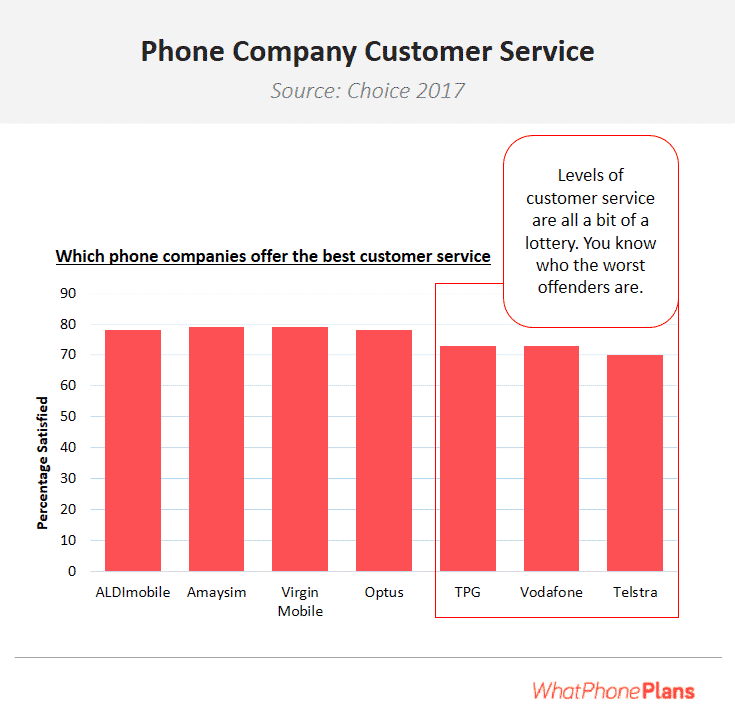
Australian levels of customer service.
Phone company customer satisfaction
Network coverage is just one of the factors you are buying when you sign an agreement with a phone company.
Determining who has the best network in Australia is not nearly as simple as it was. The gap between the best and the worst Australian network was never nearly as big as people think it is. And now, Vodafone are the best in metro areas. In the bush, Telstra is the safest bet – but, as we’ve said, you have the option of Boost Mobile.
The choice on which is more important (cost or a small network quality improvement) is very personal. This article is designed to help you weigh up the elements of the trade off which are most important to you.
5G In Australia – Closer than you might think
Each of the major phone companies agree that 2020 is the year they will launch their 5G phone services.
The vast majority of Australians have smart mobile phones these days. But even the earliest adopters of phone technology have only had 4G data speeds in their phone for 4 years. As we covered above, Telstra was first to launch. Vodafone came to market with 4G much, much later, in 2014. Even so, the major phone companies have already started making promises about 5G. Each of the major phone companies agrees that 2020 is the year they will launch their 5G phone services.
What 5G means to you?
5G appears to be a different, more considered technology evolution than those that preceded it. The essence of the move from 2G (GPRS) to 3G and then 3G to 4G was simply giving you faster data speeds. The data throughput they offered was often many times the facility of their predecessors. It became possible with 2G to download webpages, albeit slowly. 3G gave us stuttering or poor resolution video. 4G provided superfast video.
It is, perhaps, noticeable that really, these were the only benefits people were provided. For all it’s marketing machismo, they really only said ‘IT’S FAST!’ They said it a lot of different ways but that’s all they said. 5G will be deployed in to a disrupted world. Now, the internet is being used for applications that require more than just a fast dumb pipe:
- Low power :
The Internet Of Things has become a reality, connecting things to the internet like Coke Machines and cars that previously never were. These devices can be extremely small and may not be large enough to support substantial batteries. 5G is being designed to operate in a way which provides as much data throughput ( speed ) as is possible without requiring too much from devices’ batteries. - Prioritized traffic :
5G will be in use when driverless cars are on the roads. Updating it’s own position and sharing information with other driverless vehicles might mean a requirement to secure very fast access to the internet. Similarly, emergency services around the world ( notably the UK ) which previously ran their own network to arrange police and ambulance attendance very obviously need to have prioritized access to the information they need. 5G is likely to have prioritized access for different types of user. The police and emergency services will be at the top of the list coke machines at the bottom. - Faster downloads :
Data speeds are staggering on 5G. You will be able to access extremely high quality data in quantities which will allow you to completely download an entire film in seconds. It’s more likely we will download movies and video clips than stream them because it’ll be so fast and easy and it will improve the experience of watching them. - Faster streaming :
For applications such as video discussions with friends and family and telecommuting, you can expect high quality transmission and uninterrupted service. Again, it is likely that this sort of use will be prioritized. Expectations of latency ( delays ) in one on one communication are high. We become frustrated if we have to wait a few seconds to get a response from a person in a conversation. This sort of communication is likely to be assigned a higher priority over a 5G network than, say, a coke machine making a request to be restocked. - More efficient :
As we’ve said, there are going to be more things attached to the internet. Most estimates put the number of connected devices at around 15 bn. By 2020 there could be 50 billion. In technical terms, the requirements that are passed on to 5G are to be more efficient. 5G needs to use no more spectrum than was previously afforded 4G but to deal with more than 3 times as many connected users.
5G from Vodafone
Little is really known, beyond the conceptual capabilities, constraints and considerations in building a 5G network. Vodafone often benefit from their international scale by being invited to contribute to the definition of standards in the industry. Although it’s hard to believe it now, in Australia, globally, Vodafone built some beautiful 3G networks which set the standard.
Their network team and CEO have talked about 5G but have not yet said anything edifying.
5G from Telstra & Optus
Mike Write, in charge of networks for Telstra has talked publicly in very high level terms of the advantages we have outlined here.
“We’ve always been very aggressive in adopting new technology because it’s more efficient and we can show clearly it’s a lower cost to deliver more [data], customers get the latest technology and they get a better experience,”
Experience, brand and the deep pockets of Big T suggest they will go large, early, and cover a lot of Australia when they deploy 5G. Optus have made similar announcements.
Summing up 5G
Who would be a phone company? A few short years after spending billions of dollars covering Australia’s largest continent with 2G, they rolled out 3G. Then 4G. Now they have to build again for 5G. Whether we as consumers realise it or not, these network evolutions are substantial changes. They act as a backbone facility for technologies which couldn’t exist without them. When more than half of all searches and webpage views are on phones, it’s hard to imagine that YouTube or Pandora be as successful without the facility to operate on mobiles or that Google Maps would be as useful.
Albeit subtly, our already very high expectations will be raised further by 5G. At the moment, when we click a link, choose an option or decide to download a page on the internet, we expect to wait a few seconds. 5G will land in a 2020 Australia which is becoming used to fibre optic data speeds from the NBN. We’ll be used to internet interactions without delay. Everything online, whether you’re at home, outside or in the car, will become instantaneous.
We already live in a world with an expectation of immediate gratification. Add in the subconscious belief that every request you make will receive an instantaneous response ( along with the associated frustration you’ll have when it doesn’t because of a technical glitch ) and the biggest contribution 5G could make to the world is an increase in stress and potentially, the number of heart attacks. At least the ambulance will be able to transmit your bodies functioning parameters efficiently as you make your way to the hospital.
This Month’s Hot Offers













